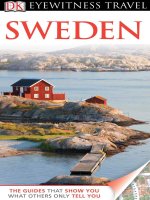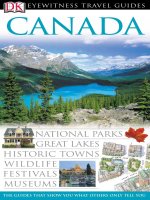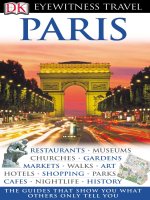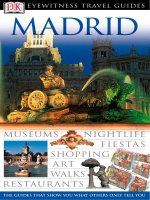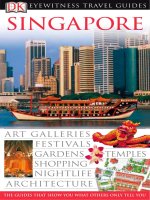sweden (dk eyewitness travel guide)
Bạn đang xem bản rút gọn của tài liệu. Xem và tải ngay bản đầy đủ của tài liệu tại đây (23.43 MB, 362 trang )
EYEWITNESS TRAVEL
SWEDENEYEWITNESS TRAVEL
SWEDEN
Skogavik nature reserve on Bullerö in the Stockholm Archipelago
The information in this
DK Eyewitness Travel Guide is checked regularly.
Every effort has been made to ensure that this book is as
up-to-date as possible at the time of going to press. Some details,
however, such as telephone numbers, opening hours, prices, gallery
hanging arrangements and travel information are liable to change.
The publishers cannot accept responsibility for any consequences
arising from the use of this book, nor for any material on third party
websites, and cannot guarantee that any website address in this
book will be a suitable source of travel information. We value the
views and suggestions of our readers very highly. Please write to:
Publisher, DK Eyewitness Travel Guides,
Dorling Kindersley, 80 Strand, London WC2R 0RL, Great Britain,
or email:
CONTENTS
INTRODUCING
SWEDEN
DISCOVERING
SWEDEN 8
PUTTING SWEDEN ON
THE MAP 12
A PORTRAIT OF
SWEDEN 14
SWEDEN THROUGH
THE YEAR 26
THE HISTORY OF
SWEDEN 30
STOCKHOLM
AREA BY AREA
STOCKHOLM AT A
GLANCE 46
GAMLA STAN 48
Erik XIV’s crown in the Treasury
at Stockholm’s Royal Palace
Summer-flowering cottongrass in
the mountains of Sylarna
PRODUCED FOR DORLING KINDERSLEY BY
Streiffert Förlag AB, Stockholm
SENIOR EDITOR
Bo Streiffert
PROJECT AND PICTURE EDITOR
Guy Engström
ASSISTANT PICTURE EDITOR
Ebba Mörner
MAIN CONTRIBUTORS
Ulf Johansson, Mona Neppenström, Kaj Sandell
PHOTOGRAPHERS
Peter Hanneberg, Erik Svensson, Jeppe Wikström
CARTOGRAPHER
Stig Söderlind
ILLUSTRATORS
Stephen Conlin, Gary Cross, Urban Frank, Claire Littlejohn,
Jan Rojmar, John Woodcock
ENGLISH TRANSLATION
Kate Lambert, Stuart Tudball
EDITOR OF ENGLISH EDITION
Jane Hutchings
Reproduced by Colourscan, Singapore
Printed and bound by South China Printing Co Ltd, China
First American edition 1995
11 12 13 14 10 9 8 7 6 5 4 3 2 1
Published in the United States by DK Publishing,
375 Hudson Street, New York, NY 10014
Reprinted with revisions 2008, 2011
Copyright 2005, 2011 © Dorling Kindersley Limited, London
A Penguin Company
ALL RIGHTS RESERVED. WITHOUT LIMITING THE RIGHTS UNDER COPYRIGHT
RESERVED ABOVE, NO PART OF THIS PUBLICATION MAY BE REPRO DUCED,
STORED IN, OR INTRODUCED INTO A RETRIEVAL SYSTEM, OR TRANSMITTED IN
ANY FORM OR BY ANY MEANS, ELECTRONIC, MECHANICAL, PHOTOCOPYING,
RECORDING OR OTHERWISE, WITHOUT THE PRIOR WRITTEN PERMISSION OF
BOTH THE COPYRIGHT OWNER AND THE ABOVE PUBLISHER OF THIS BOOK.
PUBLISHED IN GREAT BRITAIN BY DORLING KINDERSLEY LIMITED.
A CATALOG RECORD FOR THIS BOOK IS AVAILABLE FROM
THE LIBRARY OF CONGRESS.
ISSN 1542-1554
ISBN 978-0-7566-6935-5
FLOORS ARE REFERRED TO THROUGHOUT IN ACCORDANCE WITH EUROPEAN USAGE;
IE THE “FIRST FLOOR” IS THE FLOOR ABOVE GROUND LEVEL
Front cover main image: Skarhamn on island of Tjorn, Bohuslan.
STOCKHOLM STREET
FINDER 112
SWEDEN AREA
BY AREA
SWEDEN AT A GLANCE
120
EASTERN SVEALAND 122
EASTERN GOTALAND 140
GOTLAND 158
SOUTHERN GOTALAND
170
GOTHENBURG 190
SPORTS AND OUTDOOR
ACTIVITIES 320
SURVIVAL GUIDE
PRACTICAL
INFORMATION 326
TRAVEL INFORMATION
334
GENERAL INDEX 342
ACKNOWLEDGMENTS
355
PHRASE BOOK 357
STOCKHOLM
TRANSPORT MAP
Inside back cover
WHERE TO STAY 278
WHERE TO EAT 294
SHOPPING IN SWEDEN
310
ENTERTAINMENT IN
SWEDEN 316
CITY 62
BLASIEHOLMEN AND
SKEPPSHOLMEN 72
MALMARNA AND
FURTHER AFIELD 82
Lingonberries, a much-loved
Swedish fruit
Inner courtyard of Läckö Slott,
Västergötland (see p220)
Royal Palace, Stockholm
(see pp54–7)
Cross-country skiers resting on
Åreskutan mountain (see p259)
WESTERN GOTALAND
206
WESTERN SVEALAND 228
SOUTHERN NORRLAND
246
NORTHERN NORRLAND
262
TRAVELLERS’
NEEDS
SWEDEN
DISCOVERING SWEDEN 811
PUTTING SWEDEN ON THE MAP 1213
A PORTRAIT OF SWEDEN 1425
SWEDEN THROUGH THE YEAR 2629
THE HISTORY OF SWEDEN 3043
INTRODUCING SWEDEN8
STOCKHOLM
• Medieval Gamla Stan
• Vasamuseet
• Old-time Skansen
• Stunning archipelago
The Swedish capital,
Stockholm, is one of the
most delightful cities in
Europe. Draped leisurely
across 14 islands, it is an
instantly likeable blend of
medieval beauty set on water.
The heart of the city is the
old town,
Gamla Stan
(see
pp49–61), a glorious jumble
of narrow cobbled lanes and
alleyways with some splendid
Baroque architecture.
The city’s top attraction, the
Vasamuseet
(see pp90–91), is
a perfectly preserved 17th-
century warship which sank
on her maiden voyage in
Stockholm harbour.
Downtown Stockholm is
predominantly modern in
appearance, but there is a
taste of old Sweden at
Skansen
(see p92), an
outdoor museum with
timber farmhouses and barns
from across the country that
provide a glimpse from
generations back. In the
summer actors dress in
costume and give demonstra-
tions of how country folk
used to live.
While in Stockholm, try to
get out onto the water. Just
beyond the outer reaches of
the harbour, there are 24,000
islands waiting to be dis-
covered in the
archipelago
(see p110–11). Regular boat
departures head into a world
of islands and skerries
topped by pine forest, where
visitors can relax in the
sunshine, enjoy a picnic in
the forest or take a stroll
down quiet country lanes
edged by wild roses.
S
weden is one of Europe’s
best kept secrets. As
Scandinavia’s largest
country, it covers a vast range
of landscapes, from rolling
fields backed by glorious
sandy beaches in the south,
to dense pine forest and
rocky mountains in the
north. All over the country
are charming towns and
cities bursting with
fascinating museums and
great restaurants. To get the
most out of a visit to Sweden,
it is important to decide
where to focus your visit.
These pages offer a taste
of what each region has
to offer.
DISCOVERING SWEDEN
EASTERN SVEALAND
• Bustling Uppsala
• Medieval Sigtuna
• Viking-age Birka
• Majestic Gripsholms Slott
One of the great things about
the attractions of Eastern
Svealand is that they are all
within easy distance of
Stockholm. The scenery here
is dominated by Lake Mälaren
which makes a pleasant
backdrop to many journeys.
Uppsala
(see pp128–9) has
a magnificent cathedral, and
its many students give the
place the feel of a Swedish
Oxford. Much smaller and
more picturesque is
Sigtuna
(see p130), with its rows of
neat wooden houses. In
summer this quaint little
town can be swamped by
tourists, all drawn to the
impressive medieval ruins of
three churches.
There’s a wonderful boat trip
to
Birka
(see pp130–31),
which sits imposingly upon
an island in Lake Mälaren,
and takes the prize for
Sweden’s oldest town. This
is the place to learn about
Sweden’s stirring Viking
heritage, as it is rich with
archaelogical remains.
If the imposing façade of
Gripsholms Slott
(see p134)
looks familiar, it’s because it
features on the cover of
ABBA’s
Waterloo album.
Inside is one of Sweden’s
most engaging castles, full of
Gustavian flourishes.
Canoeists paddling in Lake Mälaran by Gripsholms Slott
Boathouse, Bohuslän,
Western Gotaland
Stortorget’s bustling café life in
medieval Gamla Stan
Wall-hanging depicting The Wedding in Cana and Jesus’s Entry into Jerusalem, 1781
DISCOVERING SWEDEN 9
the scenery here is altogether
more pastoral: undulating
fields of bright yellow
rapeseed backed by the
deep blue of the Baltic Sea
give Southern Götaland its
distinctive character. There’s
a sophistication in the
people, too, who enjoy
sipping a cappuccino in an
outdoor café and watching
the world go by.
If there is one place that
embodies this southern
joie
de vivre, it is handsome
Lund
(see p177), a lively student
city, whose impressive
cathedral is the envy of
the nation. Both Lund and
Sweden’s third city,
Malmö
(see pp178–81), are great
places to sample top-notch
Swedish cuisine. This part of
the country is renowned for
its picture postcard coastlines.
Alternatively, some of the
country’s best Baroque archi-
tecture is to be found at the
heart of the city of
Karlskrona
(see pp188–9) with its rich
maritime tradition.
EASTERN GOTALAND
• Vadstena Abbey
• Kolmårdens Djurpark
• Lake-side Gränna
• Kingdom of Crystal
This region is off-the-beaten-
track Sweden. Eastern
Götaland sees far fewer
tourists than other areas,
despite being home to one
of the country’s most historic
towns.
Vadstena
(see p145),
with its double attractions of
castle and medieval abbey,
makes a good stop if heading
south from Stockholm. It is a
particularly pleasant spot in
summer when the narrow,
cobbled streets are bedecked
with flowers.
GOTLAND
• Beautiful beaches
• Unspoilt Visby
• Fantastic cycling
• Medieval churches
The island of Gotland’s main
draw is golden, sandy
beaches, which compare
favourably with those of the
Mediterranean.
At the heart of Gotland is
Visby
(see pp163–7), Sweden’s
best preserved medieval city,
ringed by walls and domin-
ated at its cobbled heart by
the impressive ruins of Sankta
Karin’s church.
Leave Visby and the island’s
charms unfold: rolling green
countryside, quiet country
lands edged by pine forest
and charming fishing villages.
One of the best ways to get
around is to cycle since the
island is predominantly flat.
Along the way is another
attraction – perfectly intact
medieval churches
standing
proud against the backdrop
of the Baltic Sea.
SOUTHERN GOTALAND
• Lund cathedral
• Gourmet eating in Lund
and Malmö
• Karlskrona’s Baroque
architecture
The southern provinces are
Sweden at its most continen-
tal. Forget the pine forests
and reindeer of the north,
The Baroque Fredrikskyrkan (see
p188) on Stortorget, Karlskrona
Sweden is not associated
with wild animals such as
lions and crocodiles, but
that’s exactly what’s waiting
at
Kolmårdens Djurpark
(see
p144); this safari park comes
complete with dolphinarium,
tropicarium and ape house.
Gränna
(see p150) is a
low-key lake-side resort on
the banks of the country’s
second largest lake, Vättern.
It is a favourite with Swedes,
who come here to enjoy the
fantastic vistas and to sample
the town’s famous sweet
peppermint flavoured rock.
Admirers of glassware will
want to visit the
Kingdom of
Crystal
(see pp152–3) in
Sweden’s deep south, where
names like Kosta Boda and
Orrefors have both sales
outlets and production sites.
The unusual raukar (limestone stacks) off Gotland’s northwest coast
Coffin which transported the holy
Saint Bridget, Vadstena Abbey
INTRODUCING SWEDEN10
GOTHENBURG
• Great views from
GötheborgsUtkiken
• World-class amusement
park, Liseberg
• Quaint Haga district
• Feskekörka fish market
With canals criss-crossing the
city, Gothenburg bears more
than a passing resemblance to
its Dutch cousin, Amsterdam,
and could not be more
different from Stockholm.
Whereas the capital is grand
and imposing, Gothenburg,
Sweden’s second city, feels
altogether warmer and more
welcoming.
There is nowhere better
to get a bird’s eye view of
Scandinavia’s largest port
than from the top of the bold
red-and-white skyscraper
GötheborgsUtkiken
repelling the Danish enemy,
marks the beginning of the
coast’s sandy beaches, which
are best enjoyed at
Laholm
(see p227). Sea temperatures
here in summer are really
quite respectable, making
swimming off this part of the
Swedish coast a real pleasure.
The beaches not only stretch
for miles, but they are also
clothing-optional.
WESTERN GOTALAND
• Island retreats
• Picturesque coastal villages
• Varberg fortress
• Laholm’s sandy beaches
It is the dramatic coastline of
this part of Sweden that
makes a visit to Western
Götaland appealing. If
planning a visit to nearby
Gothenburg, it’s an easy
journey north. From smooth
granite rocks ideal for sun-
bathing to sweeping bays of
golden sands, there is sure to
be a part of this popular coast
to please.
The
Koster islands
(see
p211) are found off the shores
of Strömstad to the north and
are perfect for long carefree
days, either lazing in the sun
or exploring by bicycle. The
coastline south of this area is
renowned for its picturesque
villages. Perhaps the most
charming is modest
Fjällbacka
(see p212–3), whose narrow
streets and wooden houses
huddle around the harbour,
which was once home to a
vast herring fleet. Today, the
town is popular for swimming
and boating.
The pleasant seaside town
of
Varberg
(see p226) with its
fortress, once used for
(see p196). Gothenburgers
are justifiably proud of their
city and delighted, too, that
the
Liseberg amusement park
(see p200) is acclaimed as
Sweden’s most popular tourist
attraction, boasting the very
latest stomach-churning rides
and entertainment.
The
Haga
district (see
p201), with its narrow
pedestrianized streets and
craft stores is a quiet contrast
to the bustle of the city centre.
There is no greater pleasure
here than browsing in the
various stores and stopping
to enjoy a coffee and a piece
of apple and cinnamon pie.
For something different,
WESTERN SVEALAND
• Rolling lakeland countryside
• Örebro Slott
• Folklore villages
• Fascinating bear park
For Swedes, Western
Svealand is the most
quintessentially Swedish part
of the country: rolling hills,
pastoral farmland and
charming villages of typical
wooden homes with red
The tram from Central Station to
Liseberg amusement park
The 13th-century Örebro Slott on
the River Svartån
visitors are spoilt for choice
at the
Feskekôrka fish
market
(see p201) where
there are two excellent
restaurants at which to
sample the wares.
Wooden cottage by the tranquil waters of Strömstad, Western Götaland
DISCOVERING SWEDEN 11
NORTHERN NORRLAND
• Sandy beaches and
sunshine at Piteå
• World-famous Icehotel
• Arvidsjaur’s Sámi life
• Fantastic mountain hiking
This is Sweden at its most
elemental: extensive pine
forests and craggy
mountains, but hardly
any human habitation.
Distances between the
few settlements that
do exist here are vast
and the climate is at
its most severe.
However, one of
the sunniest places
in Sweden is also
located here:
Piteå
(see p268)
is renowned for
its long hours of summer
sunshine and superb sandy
beaches. Now a world-famous
attraction, the
Icehotel
(see
p272) at Jukkasjärvi near
Kiruna is rebuilt every winter
of ice cut from the local
river. For dog sledding or
snow-mobiling, this region is
one of the best places in
Sweden to have a go and the
Kungsleden Trail
(see p274–5)
is Sweden’s longest hiking
path at over 400 km (248
miles) long.
Arvidsjaur
(see p273) is an
excellent spot to get to grips
with the history of the
indigenous Sámi people, who
have tended their reindeer in
these parts of Swedish
Lapland for centuries. Their
characterful church village of
wooden huts and traditional
kåtor (similar to teepees) is a
good starting point.
walls and white windows.
This region is also dominated
by water – there are lakes
seemingly everywhere,
including Sweden’s largest
lake, Vänern. Take a tour of
the
Fryken lakes
(see p232),
north of Karlstad, to pass
through some stunning
lakeland countryside once
home to Sweden’s Nobel
laureate and favourite
children’s author, Selma
Lagerlöf
(see p233).
Water is also a key feature
in Örebro, an engaging city
between Karlstad and
Stockholm. The 13th-century
Örebro Slott
(see p238) sits
proudly on an island in the
River Svartån which flows
right through the heart of the
city. The north of the region
around Lake Siljan is charac-
terized by quaint villages and
undulating farmland where
Sweden’s
rich folklore
(see
pp240–41) is still alive today.
At Midsummer people don
traditional dress and dance
around the Maypole. Nearby,
the interesting
Orsa Grönklitt
bear park (see p244) offers
visitors a chance to come
face to face with the king of
the forest, as well as wolves,
lynx and wolverine.
side: endless pine
forests, remote
mountain villages and
highland pastures
used for reindeer
herding by the
country’s indigenous
people, the Sámi.
Arguably the best
coastal scenery
anywhere in the
country can be found
in this region, too.
Stretching between
Härnösand and
Örnsköldsvik, the
spectacular
High Coast
(see
p256–7) with its fjords and
islands resembles the
indented coastline of
neighbouring Norway.
Inland, the delightful lake-
side town of Östersund is
home to one of the north’s
best museums,
Jamtli
(see
p258–9), an open-air
exhibition of rural life
during the last century.
The country’s top
ski resort,
Åre
(see
p259), lies close by
and buzzes with life in
the winter season. At
any time of the
year, however, a
trip by cable car
up the Åreskutan
mountain, which
rises to 1,420 m
(4,659 ft), is an
absolute must.
Härjedalen
province (see pp260–61),
just to the north, is one of
Sweden’s most mountainous
and picturesque areas. It
is also a good place to
spot reindeer – there are
large herds in the forests
and hills around the provin-
cial capital,
Sveg
(see p261).
Picturesque farms and fjords in Ångermanland, Southern Norrland
Sámi herder tending to his reindeer
SOUTHERN NORRLAND
• The High Coast’s dramatic
coastal scenery
• Jamtli open-air museum
• Åre ski resort
• Mountains of Härjedalen
The region of Southern
Norrland offers the first
glimpse of Sweden’s wild
Sledging in winter at
Jukkasjärvi
INTRODUCING SWEDEN12
Putting Sweden on the Map
Satellite photo of Stockholm and Mälardalen, with the
inlets of Bråviken and Slätbaken to bottom left
KEY
International airport
Domestic airport
Ferry port
Motorway
Major road
Train line
International border
0 kilometres
0 miles
300
200
The kingdom of Sweden is one of the largest
countries in Europe, covering 449,964 sq km
(173,730 sq miles). The most southerly point,
Smygehuk, lies at about the same latitude as
Edinburgh in Scotland, and the northernmost tip,
Treriksröset, is nearly 300 km (186 miles) north of
the Arctic Circle. As the crow flies, Sweden is
1,572 km (977 miles) from south to north – the
same distance as from Smygehuk to Rome. Sweden
shares land borders with Norway to the west and
Finland to the east, and water borders with Germany,
Poland, Estonia, Latvia, Lithuania, Russia and
Denmark, which lies across the Kattegat.
A
r
c
t
i
c
C
i
r
c
l
e
E18
E6
E6
E6
E14
E39
E39
E39
E45
E18
E16
E16
SKAGERRAK
NORTH SEA
NORWEGIAN SEA
Newcastle
Harwich
Amsterdam
OSLO
Strömstad
Hirtshals
Hanstholm
Esbjerg
Frederiks-
havn
Kristiansand
Kiel
Grenå
Stavanger
Bor
å
COPENHAGEN
Helsingör
Helsingborg
Varberg
KATTEGAT
Halmstad
Malmö
Bergen
Trondheim
Billund
Arhus
Aalborg
Gothenburg
Sandefjord
NORWAY
DENMARK
PUTTING SWEDEN ON THE MAP 13
GREATER STOCKHOLM
NORTHERN EUROPE
0 kilometres
0 miles
50
30
E18
E20
E4
E4
E18
276
77
55
73
55
56
53
66
70
53
55
55
57
76
72
67
Mälaren
BALTIC SEA
Arlanda
Skavsta
Bromma
Uppsala
Västerås
Eskilstuna
Mariefred
Nyköping
Vaxholm
Sigtuna
Nynäshamn
Norrtälje
Trosa
Södertälje
Enköping
Strängnäs
Stockholm
ICELAND
SWEDEN
FINLAND
GREAT
BRITAIN
IRELAND
GERMANY
POLAND
BELARUS
RUSSIA
UKRAINE
FRANCE
ITALY
ROMANIA
DENMARK
ESTONIA
LATVIA
LITHUANIA
RUSS. FED.
LUXEMBOURG
NETHERLANDS
BELGIUM
SWITZERLAND
AUSTRIA
CZECH REP.
SLOVAKIA
HUNGARY
MOLDOVA
SPAIN
SLOVENIA
CROATIA
NORWAY
E6
E6
E6
E75
E14
E12
E10
E10
E8
E10
E12
BALTIC SEA
GULF OF FINLAND
Vänern
Vättern
BALTIC SEA
Skellefteälven
Kalixälven
Torneälven
Ljusnan
Stor-
sjön
Siljan
Torneträsk
GULF OF BOTHNIA
GULF OF BOTHNIA
Riga
Ventspils
Klaipeda
Liepaja
Åland
Bornholm
å
s
Karlskrona
Karlshamn
Åhus
Rönne
Gdynia
Gdansk
Ystad
Trelleborg
Sassnitz
Kalmar
Oskarshamn
Växjö
Visby
Västervik
Norrköping
Karlstad
Örebro
Nynäshamn
Linköping
Jönköping
STOCKHOLM
Fagersta
Borlänge
Falun
Mora
Sveg
Hudiksvall
Sundsvall
Härnösand
Örnsköldsvik
Umeå
Vaasa
Skellefteå
Piteå
Arvidsjaur
Hemavan
Arjeplog
Jokkmokk
Gällivare
Pajala
Kiruna
Abisko
Luleå
Boden
Östersund
Gävle
Mariehamn
Kapellskär
Grisslehamn
Eckerö
TALLINN
Turku/Åbo
HELSINKI
Mo i
Rana
Narvik
Haparanda
Bodø
FINLAND
RUSSIA
ESTONIA
SWEDEN
Crown Princess Victoria and Princess Madeleine in national costume on Swedish Flag Day
Start of the annual Vasaloppet race, which attracts more than 16,000 skiers
Few nations in Europe offer
such an exceptionally
diverse landscape, rich in
flora and fauna, as
Sweden. From north of the
Arctic Circle the country stretches a
lengthy 1,572 km (977 miles) south,
a distance equal to almost half the
length of Europe.
The extreme north is the land of
the midnight sun, where daylight
lasts for 24 hours in high summer,
but is almost non-existent in mid-
winter. Moving southwards, the
forests and wetlands of Norrland
provide habitats for large numbers
of elk and a thriving birdlife.
In the far south, the rolling plains
of Skåne and the area around the
great lakes make good arable land.
To the east, the green islands of
the Stockholm archipelago
contrast with the bare rocky
outline of the west coast.
A COUNTRY SHAPED BY ICE
The mountain chain which runs
along part of Sweden’s border with
northern Norway has several peaks
more than 2,000 m (6,500 ft) high. It
was formed when the ice which
covered the country until 10,000
years ago retreated northwards.
Several glaciers from this time still
linger in the north.
THE CLIMATE
Sweden has a relatively mild climate
for its northerly location. However,
because of the length of the
A PORTRAIT OF SWEDEN
Elk
S
wedes are passionate about nature and the outdoors, and
justly so since their country contains some of Europe’s last
surviving areas of wilderness. As a nation, Sweden has built
its wealth on its natural resources and the ingenuity of its engineers.
It has a heritage rich in music, literature and folk traditions and its
people have a deep-rooted sense of peace and democracy.
INTRODUCING SWEDEN16
country, the temperature in autumn
and spring can vary by more than
20° C (68° F) from one end to the
other. Northern Sweden holds the
record for the coldest temperature of
-53° C (-63° F), while Ultuna, near
Uppsala, has recorded the highest
temperature of 38° C (100° F). There
are occasional green winters in
southern Sweden, but the heaviest
snow fell in 1998, with 150 cm (5 ft)
accumulating on 4–5 December in
Gävle in central Sweden.
SPACE FOR ALL
Sweden covers an area of
449,964 sq km (173,731 sq
miles), and with just 9 million
inhabitants Swedes have
plenty of space. In the forested
areas, towns can be few and far
between.
Towards the end of the 19th
century and thanks largely to
the coming of the railways, Sweden
began to exploit her rich natural
resources. Forestry and copper
industries were established and the
rivers were harnessed to produce
hydroelectricity. Large manufacturing
companies began to develop, such as
Ericsson, Volvo and Scania, all of
which are still in operation today.
The needs of industry led to a
massive shift in population. Today 85
per cent of the Swedish population
lives in the cities and less than 2 per
cent is employed in agriculture.
In the post-war period the need for
labour led to immigration. Flows of
immigrants became even greater at
the end of the 20th century with the
arrival of refugees from the world’s
trouble spots.
GOVERNMENT AND POLITICS
Sweden is both a parliamentary
democracy and a hereditary monarchy.
As the head of state, the king has no
political power, but he is considered
to be an important representative of
Sweden to the rest of the world. Carl
XVI Gustaf is the descendant of one
of Napoleon’s marshals, Jean-Baptiste
Bernadotte, who was chosen as the
heir to the throne of the last of the
Vasa kings, the childless Karl XIII.
The Frenchman was crowned in 1818
as Carl XIV Johan, King of Sweden
and Norway. Carl XVI Gustaf came to
the throne in 1973 and married the
German Silvia Sommerlath. Despite
doubt over the king’s choice of a
commoner for his bride, Swedes
soon took Queen Silvia to their
hearts. The couple’s eldest
daughter, Crown Princess
Victoria, is the heir to the throne.
Sweden’s parliament, the
Riksdag, has 349 members
and is Sweden’s legislative
assembly. Elections are held
every four years.
Since World War II, a balance has
prevailed between the socialist and
non-socialist parties in parliament.
With only a few exceptions, the
Social Democrats, as the largest
group, have governed, either alone
or with smaller supporting parties.
Taxation has reached record levels,
but the majority of Swedes tend to
believe that they get value for
money. However, an economic crisis
in the 1990s led to cuts in health,
Lars Magnus Ericsson, setting Sweden on the path to
industrialization by founding Ericsson in 1876
Emblem of
state
A PORTRAIT OF SWEDEN 17
education and social care. The
environment is a key issue. Swedes
have a deep-rooted love of nature,
enshrined in the Right to Roam,
which guarantees free access to the
forests and countryside and the right
to pick berries and mushrooms.
There is widespread support for
combating pollution.
LANGUAGES AND DIALECTS
While Swedish is the dominant
language, Finnish, Tornedalsfinska
(the dialect of Finnish spoken in the
Torne Valley) and Sami are all official
minority languages. The largest of
these is Finnish with around 20,000
speakers, while Sami is spoken by
about 10,000 people. Despite the
general use of standard Swedish,
dialects also flourish. The majority is
multilingual and Swedes in general
are often fluent in English.
RICH CULTURE
Besides the many specialist museums
in the cities, there are more than 1,000
rural museums. Great interest is shown
in art and handicrafts which can be
seen in the galleries and shops.
Swedes are keen musicians, and
many play in local orchestras or sing
in choirs. Folk music and dancing
enjoy a natural high season from
Midsummer to the end of August.
The story of film culture also has a
Swedish chapter, thanks to stars such
as Greta Garbo and Ingrid Bergman.
A SPORTING NATION
Sweden’s abundance of clean, unpol-
luted waters makes fishing a popular
hobby, and the long coastline, glorious
archi pelagos and numerous water-
ways have made it a nation of sailors.
For a small nation Sweden has
proud traditions, especially in winter
sports. Skiing and ice hockey as well
as football, handball, bandy (Russian
hockey), tennis and golf, all set
Swedish pulses racing, while swim-
ming, athletics, boxing, water sports
and motorsports also number several
stars at international level (see p25).
SWEDEN ON THE WORLD STAGE
The neutrality which protected
Sweden from two world wars has
remained a guiding principle.
Sweden did not join NATO, choosing
instead to focus on its own defence
and related industry.
Sweden has been a member of the
EU since 1995 and elections to the
European Parliament are held every
five years. The attitude towards the
EU is divided and in 2003, the
Swedes voted “no” to adopting the
euro by a considerable majority.
Sweden is an enthusiastic advocate
for the work of the UN. Its own Dag
Hammarskjöld was a celebrated
Secretary-General (1953–61), and
Swedish troops have been involved
in peace initiatives worldwide.
Ideal conditions for Sweden’s sailing enthusiasts
in sheltered archipelagos
Berry- and mushroom-picking in rural areas, with
permission under Sweden’s Right to Roam
INTRODUCING SWEDEN18
Landscape and Wildlife
Sweden has a remarkably varied landscape. The flat
arable land of Skåne in the south gives way to lakes
and forests, rugged mountains, fast-flowing rivers
and wild open moorland further north, leading to
the Arctic tundra. Plant and animal species from
both continental Europe and the Arctic thrive. Large
areas of wilderness have become enclaves where
endangered species such as bears and wolves, snakes
and owls have been able to survive the pressure from
civilization. The coastline, too, is immensely varied.
Marine life is unique, as North Sea fish make their
way into the brackish water of the Baltic and mix
with species normally only found in fresh water.
Wolves
are a threatened species
and, despite migration from
neighbouring countries, there
are only around 200 in Sweden.
COASTS AND ISLANDS
Smooth rocks and sandy beaches dominate
the west coast, where marine life includes
saltwater fish such as cod and haddock.
Freshwater pike and whitefish can be
found off the northerly stretches of the east
coast. On the limestone islands of Öland
and Gotland orchid meadows flourish.
THE ARABLE SOUTH
The flat lands of Skåne with their fields of
crops, willow windbreaks and half-timbered
houses topped by storks’ nests are a familiar
image of Sweden. But just as typical are
the stony pastures and juniper slopes of
Småland surrounding red cottages, and the
meadows and pasture lands of Mälardalen.
Seals
declined in
number as a result of
hunting, pollution and
disease. But now popu-
lations of grey seals,
ringed seals and
harbour seals (pictured)
are increasing, thanks
to their protected status.
Sea eagles,
with a
wing span of up to
250 cm (8 ft), are
Sweden’s largest
birds of prey. They
nest along the east
coast and also on
lakes in Lappland.
Roe deer
were
almost extinct in the
early 19th century.
Now they are so
common in southern
and central Sweden
that they are known
to raid local gardens
in search of food.
Hedgehogs
rely on
their 5,000 spines for
protection and curl into
a ball at the approach
of danger. But this is of
little effect against cars,
and the popular door-
step guest is in decline.
A PORTRAIT OF SWEDEN 19
The ptarmigan
lives
above the tree line and
is often encountered,
as it is unafraid of
mountain hikers. It
follows the changing
seasons with up to four
changes of plumage.
FORESTS
More than half of Sweden’s land area is
covered by forests, with deciduous trees in
the south, coniferous forests with pines and
spruce further north. Here lingonberries,
blueberries and chanterelles grow. This is
the home of elk and beaver, and forest
birds such as capercaillies and black grouse.
THE FAR NORTH
The mountains and moorlands are character-
ized by their proximity to the Arctic. With
late spring come the migratory birds such
as hooper swans and the lesser white-
fronted goose, and the mountain flora bursts
into flower. Wolves, bears, wolverine and
lynx inhabit the national parks.
Reindeer
live as
domesticated animals
in northern Sweden,
farmed by Sami in
the mountains and
forests. In winter the
herds move further
south to graze.
The brown bear
is
the largest of Sweden’s
predators and can
weigh up to 300 kg
(660 lb). It may look
slow, but it moves
quickly and is dan-
gerous if disturbed.
The elk
is the big game
of the forest. Around
100,000 elk are killed
in the annual hunting
season and, despite the
road warning signs,
others die in accidents
involving cars.
SWEDEN’S FLORA
Considering Sweden’s unusually rich flora, it is not surprising
that the father of botany, Carl von Linné (see p128), was
born here. There are more than 2,000 species of flowers
alone. After a long cold winter, nature explodes into life
with a profusion of blooms, as in the orchid meadows of
Öland. Swedes’ love of wild flowers is illustrated by the
maypoles and garlands used to celebrate Midsummer.
Wood
anemones
carpeting the
forests signal
the arrival
of spring.
King Karl’s Spire
can grow
1 m (3 ft) tall – an impres-
sive height for an orchid.
It is most common in
swampy mountain areas.
The red water-
lily
can only
be found
in some lakes
in Tiveden
National Park.
INTRODUCING SWEDEN20
HALSINGLAND’S MANOR HOUSES
Reaping the benefits from the lucrative
19th-century timber industry, the forest-
owning farmers of Hälsingland built
themselves extravagant manor houses.
The size of house and magnificence of the
painted portico reflected the owner’s
wealth and status. The interiors were often
decorated with wall paintings.
Interlocking posts
bind
together the external and
interior walls, while the
façades are often boarded.
Sweden’s Wooden Houses
The quintessential image of Sweden is the red-and-white
painted wooden cottage. Originally, wooden houses
were not considered attractive so they were painted red to
make them look as though they were built of brick, or
yellow to represent stone, and this tradition has continued.
Every building from the humblest hut to the most majestic
mansion was made of timber from the large tracts of forest.
Wood triumphs in the grandiose manor houses of
Hälsingland and the decoratively carved merchants’ homes
of the Stockholm Archipelago. Even today, architects are
developing innovative ways of using this classic material.
Skogaholm Manor
Built in the 1680s, this Carolian timber house
from Närke was originally painted red. In the
1790s, it was given a yellow plaster façade and
large windows in line with Gustavian style. More
recently it was moved to the museum at Skansen.
Societetshuset
Decorative wooden
buildings, such as this
club house for wealthy
visitors to the seaside
town of Marstrand (see
p216), were a feature
of the fashionable west
coast bathing resorts in
the late 19th century.
Bell Tower
Many 18th-century
churches had wooden
bell towers: Delsbo’s,
with its elegant onion
cupola, dates from 1742.
Hut in Härjedalen
This simple log-built hut in the mountain
pasture of Ruändan incorporates the
centuries-old tradition of a grass roof.
Swedenborg’s
Pavilion
The miniature manor
house of philosopher
Emanuel Swedenborg
(1688–1772). It is now
at Skansen (see p92).
The façade
is clad in
pine and painted with
a copper-vitriol paint,
known as Falu red, to
prevent rotting.
A PORTRAIT OF SWEDEN 21
Fishing Cottages at
Kungshamn
In fishing villages on the
rocky islands of Bohuslän,
where space is tight,
timber-clad houses in
pastel shades crowd in
higgledy-piggledy fashion
around the harbours.
Merchant’s House in the Archipelago
In the late 19th century Stockholm’s upper
middle classes spent their summers in the
archipelago, where they built magnificent
wooden villas with verandas, summer
houses, bathing huts and boat houses.
Modern Wooden Architecture
The Nordic Watercolour Museum in
Skärhamn on the west coast opened in 2000.
The Danish architects Bruun/Corfitsen have
clad the building’s steel and concrete shell
with vertical wooden panels in red, using this
traditional material in a public setting.
Two-storey houses
are
common in Hälsingland. The
finest have an attic floor
with half-windows.
Wooden Lighthouse
Dating from 1840, the
wooden lighthouse at
Bönan also served as a
pilot station. It marked
the shipping route into
Gävle. The building is
now a museum.
Decorative Woodwork
More expensive wooden
houses dating from
around 1900 were often
a riot of fretwork and
rich ornamentation,
known as “carpenter’s
joy”, on verandas,
entrances and gables.
Porticoes
and outer
doors are particularly
richly ornamented and
painted. Other details
include turned pillars,
intricate woodcarving
and elegant roofs.
The designs vary from
parish to parish.
Foundations
are a course of
cobblestones.
INTRODUCING SWEDEN22
Globalization and the gradual erosion of
regional identity over the last 50 years have
had a major impact on Swedish traditions and
lifestyle. Much of the formerly rigid etiquette
has been relaxed and today Swedes are
more informal when it comes to dress and
manners. However, despite this culture shift,
Swedes still hold onto their roots, local cus-
toms, history and traditions. They are pas-
sionate about their little red cottages, the
countryside, eating herring at Midsummer
and enjoying the first fresh strawberries.
FEASTS AND FESTIVITIES
Celebrating the high points
of the year within the family
has again become increas-
ingly important, after a
dismissive attitude towards
tradition in the 1960s and 70s.
Many traditions have pagan
origins, most of them related
to the coming and going of
seasons, and are an excuse to
eat special treats and play
games. The most important is
Midsummer, the summer sol-
stice feast. Along with dancing
and games around the may-
pole, the light, short night
(when all sorts of magic is in
the air) can be marked by
watching the sun set and rise
a few hours apart (or hardly
at all in the north). For those
who go to bed it is the cus-
tom to pick seven different
flowers in silence and place
them under their pillow; their
future partner will appear in
their dreams. Walpurgis night,
30 April, is when the last day
of winter is chased away with
huge bonfires, and songs and
speeches welcome spring.
Lucia Day, in December, is an
intricate mix of pagan and
Christian, a festival of light at
the onslaught of darkness,
which has adopted a Christian
martyr as its symbol of hope
and bringer of light. Every
school, office and church has
a Lucia, a girl dressed in white
with a red ribbon around her
waist symbolizing the martyr’s
blood, and a crown of candles
on her head
(see p29).
Easter also has elements of
old folk beliefs. Maundy
Thursday is the day witches
fly to Blåkulla
(see p154) to
dance with the devil. Today,
children dress up, broom-
sticks and all, and give
handmade Easter greetings
cards in exchange for sweets.
Christmas is preceded by the
hectic run-up of Advent,
when Swedes go partying
and consume vast quantities
of
glögg (mulled wine usually
mixed with cognac or vodka),
lussebullar (saffron buns) and
pepparkakor (ginger snaps).
SINGERS AND MUSICIANS
More than half a million
Swedes sing in a choir, and
their passion for song is
reflected not just in singing
DRESS AND ETIQUETTE
Those who own a folk
costume take it out for
midsummer, folk dances,
weddings and other formal
occasions. Each region has its
own historic style and there is
also a national dress
(see
p14). The Sami have their
own elaborate costumes.
At weddings people are
expected to dress up, as
specified on the invitation
(white tie, black tie or suit).
In everyday life, style is more
casual, especially in summer.
Although Swedes are more
easy-going these days, they
are still fond of etiquette. It is
important to know how to
“skål”. Swedes first raise their
glass to their female partner
at the table, and then to the
hostess. People look each
other in the eye while raising
their glass and saying
“skål”,
looking down as they drink
and then re-establishing eye
contact before putting down
their glass. If the
skål is com-
munal, everyone has to look
each person around the table
in the eye before drinking.
Despite this interest in
etiquette, Swedes tend not to
observe minor courtesies such
as holding open doors or
apologizing when they bump
into someone. They are very
informal when addressing
one another; everyone is on
first name terms from the start,
even when doing business.
Traditions, Customs and Folklore
Midsummer celebrations with games and dancing round the maypole
Sami in traditional costume for a
celebratory occasion
Folk
musician
A PORTRAIT OF SWEDEN 23
A COUNTRY COTTAGE
The little red cottage is the
symbol of paradise. Maybe
it is the Swedes’ farming
roots combined with the
CLOSE TO NATURE
The Swedes’ love of nature
is deeply rooted. Many feel,
subconsciously, an almost
spiritual affinity with the
forest, mountains or the sea.
Legends and folklore are
often linked to nature and
many mythical beings are
part of country lore. Trolls
dwell in the forest, as does
the Skogsrå or Huldra
(siren), a beautiful young
woman who lures men
deeper and deeper into the
woods and then, once they
are lost, she turns around
and all there is to be seen is
a hollow tree. Women who
stroll too far might hear a
lovely tune drifting among
the trees – that is Näcken, a
handsome naked man,
playing his fiddle in the
middle of gushing streams
at parties and the ever-
increasing repertoire of
drinking songs, but also in
the popularity of singing
together. There are few 50th
birthday parties where each
plate doesn’t come with a
songbook or where friends
don’t perform songs they
have written themselves.
Everyone is expected to
know works by troubadour
Carl Bellman and ballads by
Evert Taube
(see p60).
Folk music is played at
clubs and there are festivals
dedicated to folk instruments
such as the accordion and
hurdy-gurdy. Pageants and
history plays have also seen
a huge upturn in popularity
in recent years.
CULINARY TRADITIONS
People are rediscovering
old Swedish dishes and there
has been something of a
revival in
husmanskost
(“home-cooking”). Few,
however, have
time to prepare
these at home
on a daily
basis, so
childhood favourites
such as
kalops (a
slow-cooked meat
stew),
köttbullar
(meatballs) and freshly
cleaned and fried herring
fillets are now often enjoyed
in restaurants.
Swedes drink lots of coffee,
and at work the
fika paus
(coffee break) is strictly
observed. In fact,
fika is
something everyone does, as
proven by the large number
of cafés even in small towns.
To accompany coffee there
is a great variety of
bullar
(buns), cakes, gateaux and
biscuits. Home-made sponge
cake layered with lots of
whipped cream and straw-
berries is a summer favourite,
especially for birthdays.
brief summer which makes
having a holiday house in the
countryside or out on an
island such a major ambition.
When spring comes, people
head out to tend their cottage
gardens, and as the autumn
nights draw in they are still
at their cottages, curled up
by the fire. Almost half the
population have access to a
summer cottage and 20 per
cent own one of their own.
and, needless to say, it is
best to stay away from him.
Giants and dwarfs roam the
mountains while elves dance
in the meadows and marsh-
lands. Some beings have
adopted modern guises. The
Tomte, who traditionally is a
stern, grey little man guarding
farmers’ barns and livestock,
has been transformed into a
kindly distributor of Christ-
mas gifts. In the countryside,
however, a plate of Christmas
porridge is left for him on
the doorstep, just to be safe.
There is a strong aware-
ness of the changing seasons,
linked to how deeply Swedes
long for the bright summer.
Spring is a slow affair, build-
ing up with the blossoming
of one flower at a time,
each one eagerly
awaited. People
know when each
bloom is due,
hence expressions
like “between bird
cherry and lilac” (ie
“at end of May”).
On a more practical note,
it is easy to be physically
close to nature thanks to the
Right to Roam. This grants
everyone access to all land,
apart from the immediate
surroundings of a house or
farm
(see p320). Many make
the most of this resource,
walking, camping, or going
mushroom- or berry-picking.
Painting depicting mythical beings
in the forest
A tournament during Medieval Week, a popular pageant in Visby
Strawberry
cream cake

